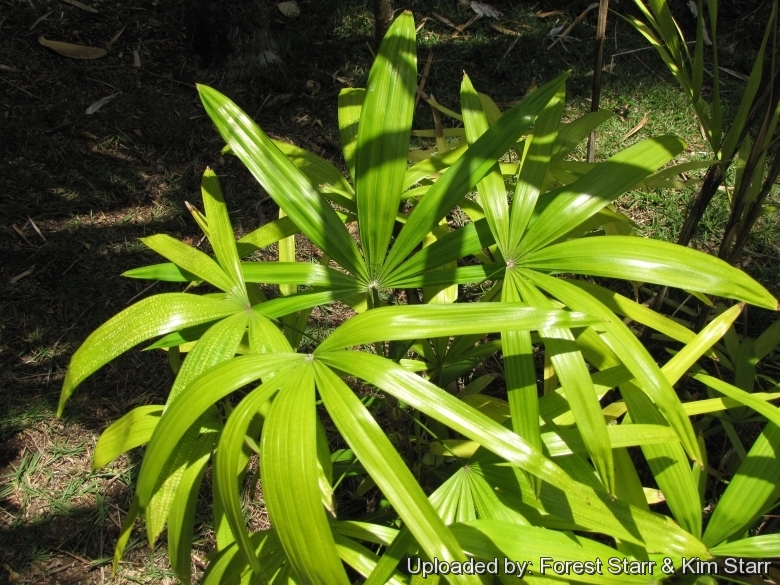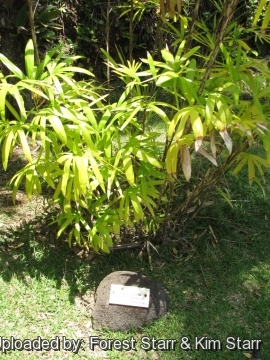




Your support is critical to our success.

Fronds at Iao Tropical Gardens of Maui, Maui, Hawaii (USA). May 22, 2012.
Origin and Habitat: Cambodia, Laos, Sumatera, Vietnam and Thailand. Thailand — EASTERN: Nakhon Ratchasima; SOUTH-WESTERN: Phetchaburi; SOUTH-EASTERN: Chanthaburi; PENINSULAR: Nakhon Si Thammarat, Phatthalung, Trang, Songkhla.
Altitude range: 40–200 metres above sea level.
Habit: Rhapis subtilisSN|28688]]SN|28688]] is an understorey plant that grows on limestone slopes, in evergreen forest.
Synonyms:
- Rhapis subtilis Becc.
Rhapis subtilis Becc.
Webbia 3: 227 (1910)
Synonymy: 2
- Rhapis subtilis Becc.
- Rhapis siamensis Hodel
ENGLISH: Thailand Lady Palm, Dwarf lady palm, Thai lady palm, Tonkin's canes (trunks)
GERMAN (Deutsch): Thai Lady Palme
THAI (ภาษาไทย): Chang thai (จั๋งไทย), Chang tai (จั๋งใต้), จั๋งนิ้วมือ
Description: Rhapis subtilisSN|28675]]SN|28688]] is a small, tightly clustered evergreen palm species growing in groups and rarely larger than 1.5-3 m high. It has many thin, bamboo-like stems that grow from the underground rhizome (root) and give the palm the appearance of a bush eventually, especially in tropics, can spread quite a ways creating a large wall of palms. Each stems developed at the end several leaves, which are divided into several segments and are fan-like. It has a tendency to have less splits in its leaves than the more common Rhapis excelsaSN|28675]]SN|28675]], with some cultivars having only 0-1 splits. Variegated forms exist but are very rare and pricey.
Stems: Individual stems/canes 2–3 m tall, (6-) 8–15 (-25) mm in diameter with coarse fibers producing a diagonal lined, squared open, mesh. The stems tend to be naked in older plants, without as much fibres as with Rhapis excelsaSN|28675]]SN|28675]] but ligule sometimes remaining intact at maturity.
Leaves: 7–18 in crown, costapalmate. Leaf sheath 10–15 cm long, often with persistent ligule. Petiole 20–25 cm long, 1-3 mm across. Blade V-shaped or semicircular in outline, flattened, glossy dark green to pale green abaxially as well as adaxially, varible in size up to 40 cm in diameter, splitting variable to 0.1–17 cm from hastula, segments (1-)2–11, 7–25-folded, to 38 cm long, transverse veinlets very conspicuous. The leaf tips are usually nearly pointed, but sometimes have that look like they were cut with a pinking shears, as in Rhapis excelsaSN|28688]]SN|28675]].
Inflorescences (panicles): Male and female inflorescence similar, branched to 1–2 orders, to 30–50(–60) cm long, prophyll and rachis bracts similar, overlapping not inflated. peduncle relatively long, to 22 cm, glabrous. Rachis 6–30 cm long with two first order branches, rachillae usually few, 3–25 cm long.
Flowers: Small creamy white, 5–6.5 mm long, different sexual types of flowers similar, calyx irregularly lobed, evenly pigmented, male flowers slightly longer than the female and hermaphroditic ones.
Fruit: Globose, 8–10 mm diameter, 1–3 borne on an up to 2 mm long receptacular stalk.
Bibliography: Major references and further lectures
1) Forest & Kim Starr Rhapis subtilis (Dwarf lady palm, Thai lady palm). Plants of Hawaii. <http://www.starrenvironmental.com>. Downloaded on 28 August 2014.
2) "Rhapis subtilis Becc." Palms of Thailand ปาล์มในประเทศไทย <http://thaipalm.myspecies.info/taxonomy/term/1041> Accessed on 28 Aug. 2014
3) Wikipedia contributors. "Rhapis" Wikipedia, The Free Encyclopedia. Wikipedia, The Free Encyclopedia, 7 Jun. 2014. Web. 8 Sep. 2014.
4) Palmpedia contributors. "Rhapis subtilis." Palmpedia, PALM ENCYCLOPEDIA, <http://www.palmpedia.net> Downloaded on 8 Sep. 2014
5) "Rhapis subtilis." PACSOA Palms and Cycads wiki , <http://www.pacsoa.org.au> Accessed on 28 Aug. 2014
6) Riffle, R. L. and P. Craft. “An encyclopedia of cultivated palms”. Portland, OR: Timber Press, Inc.2003
7) Andrew Henderson “Palms of Southern Asia” Princeton University Press, 27/Apr/2009
8) Michael J. Balick, Hans T. Beck “Useful Palms of the World” Columbia University Press, 1990

Habit with sign at Iao Tropical Gardens of Maui, Maui, Hawaii (USA). May 22, 2012. Photo by: Forest Starr & Kim Starr

Habit at Iao Tropical Gardens of Maui, Maui, Hawaii (USA). May 22, 2012. Photo by: Forest Starr & Kim Starr

Stem at Iao Tropical Gardens of Maui, Maui, Hawaii (USA). May 22, 2012. Photo by: Forest Starr & Kim Starr
The gallery now contains thousands of pictures, however it is possible to do even more. We are, of course, seeking photos of species not yet shown in the gallery but not only that, we are also looking for better pictures than those already present. Read More...
Cultivation and Propagation: Rhapis subtilisSN|28688]]SN|28688]] is an excellent garden plant adapt to different tropical climates. It is a tropical, very easy to maintain palm that practically thrives on neglect in the tropics. It is also one of the most elegant indoor palms. Not many palms excell as indoor palms as Rhapis species. These palms seem to get greener and greener the more darkness they live in.
Soil requirements: It is very adaptable to soil types although neutral to slightly acid soils with good drainage and organic matter is recommended for best results. Avoid soils that are constantly soggy.
Watering: Though drought and heat tolerant, it benefits from regular watering, especially during the dry seasons and should be watered before the soil completely dries. Don't let sit in water. Indoor, potted Rhapis should not be over-watered. They may contract the fungus Phytophthora, if over-watered. The better the quality of water applied the better your plants will grow in the long run, particularly plants grown in containers. Plants held indoors benefit by being taken outside when it is raining or being placed under a sprinkler for a period of time.
Light: Outside they grow best in half sun but tolerating direct sun as long as soils are good and adequate water is available. Young specimens need protection from direct sunlight and grow best in shady to partly shady locations so for best results a partially shaded spot under trees or a pergola is ideal. With some sun the leaf crowns become larger and the stems attain greater diameters. However, it can grow in various light conditions, from bright light or full sun to full shade, or part sun/part shade. If home-grown, they look their best in bright diffuse light.
Fertilization: Need a perfect low-release fertilizer (e.g., 18-18-18) diet including all micro nutrients and trace elements. It is subject to magnesium and potassium deficiency
Hardiness: Rhapis subtilisSN|28688]]SN|28688]] is fairly similar to Rhapis excelsa except that it is tropical in its requirements. For safe cultivation normal temperatures should not go below 5°. (USDA hardiness zones: 10B through 11) Where not hardy, grow as an indoor palm in containers.
Wind tolerance: Keep out of high, drying and cold winds, needs high atmospheric humidity.
Salt aerosol tolerance: Moderate.
Maintenance: Remove dried fronds. Trim off or remove some small basal shoots if there are one too many, especially if container-grown to reduce congestion and improve aeration. You can then use these suckers to propagate as new plants.
Garden uses: It is an ideal planting in beds as well as a pot plant for indoor and outdoor use and looks very nice in front of Rhapis humilis. Rhapis subtilisSN|28688]]SN|28688]] can also be planted under trees and tolerates the conditions near the sea. It can be container-grown if garden space is unavailable and has a fairly good employment, in pot, for indoor decoration. Its low light and humidity requirements make it a common feature in malls and offices. As an indoor plant Rhapis subtilis has no palm rival. (Not even Howea forsterianaSN|24502]]SN|24502]]. ) Its ability to handle low light intensities, low humidity, varying temperatures plus its suitability to pot culture, small to moderate size and slow growth rate make this palm ideal for indoor culture.
Other uses: The trunks are known as Tonkin's canes and are used as chopsticks and waking stikcks. There are four categories of cane, which are classified according to quality and cane diameter. In order to be used as walking sticks or umbrella handles, the stem has to be black underneath the bark; young stems that are white underneath do not have enough resistance and are used for fans. The stems have to be straightened in a fire, scrapped, and polished before being exported.
Disease & Pests: Protect against spider mites, scale insects and mealybug. Brown or black fungal spot is usually caused by poor cultural practices and too crowd plants much so as to allow unimpeded air flow to reduce conditions ideal for the fungus. They may require regular fertilization to prevent yellowing caused by potassium deficiencies; Brown leaf tips are often caused by an excessive accumulation of fertiliser salts in the potting mix. Protect from frost.
Propagation: By seeds, though Rhapis subtilisSN|28688]]SN|28688]] more readily propagates via division of the root ball.
| Your Actions | |
|---|---|
| Back to Rhapis index | |
| Back to Arecaceae index | |
 |
Back to Palms And Cycads Encyclopedia index |
Privacy stantement - Terms and conditions - How to cite - About us - Feedback - Donate


